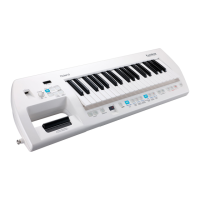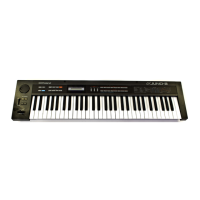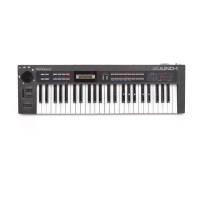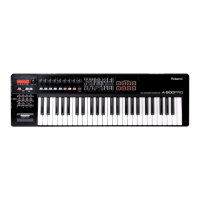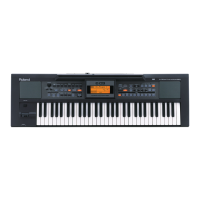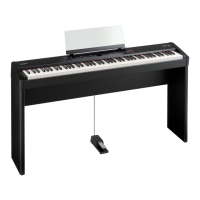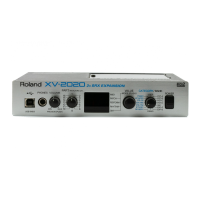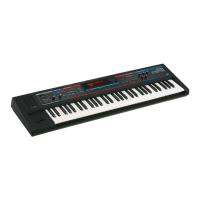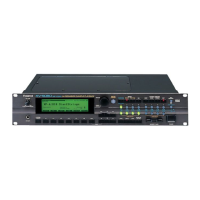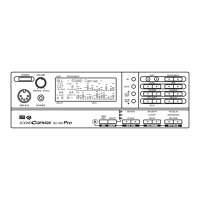MFX/IFX Parameters
51
30 DISTORTION
Produces a more intense distortion than Overdrive.
L in
R in
L out
R out
Pan L
Pan R
Parameter Value Explanation
Drive 0–127
Degree of distortion
Also changes the volume.
Tone 0–127 Sound quality of the Overdrive effect
Amp Switch OFF, ON Turns the Amp Simulator on/off.
AmpType
(Amp Type)
SMALL,
BUILT-IN, 2-STACK,
3-STACK
Type of guitar amp
SMALL: Small amp
BUILT-IN: Single-unit type amp
2-STACK: Large double stack amp
3-STACK: Large triple stack amp
Low Gain -15–+15 [dB]
Amount of boost/cut for the low-
frequency range
High Gain -15–+15 [dB]
Amount of boost/cut for the high-
frequency range
Pan L64–63R Stereo location of the output sound
Level 0–127 Output Level
31 T-SCREAM
This models a classic analog overdrive. It is distinctive in adding an
appropriate amount of overtones without muddying the sound.
L in L out
R outR in
Parameter Value Explanation
Distortion 0–127
Degree of distortion
Also changes the volume.
Tone 0–127 Tonal character of the overdrive
Level 0–127 Output Level
32 GUITAR AMP SIM
This is an effect that simulates the sound of a guitar amplifier.
L in
R in
L out
R out
Pan L
Pan R
Parameter Value Explanation
Pre Amp Sw
(Pre Amp Switch)
OFF, ON Turns the amp switch on/off.
Type
(Pre Amp Type)
Type of guitar amp
JC-120
This models the sound of the Roland
JC-120.
CLEAN TWIN This models a Fender Twin Reverb.
MATCH DRIVE
This models the sound input to left input
on a Matchless D/C-30.
A simulation of the latest tube amp
widely used in styles from blues and rock.
BG LEAD
This models the lead sound of the MESA/
Boogie combo amp.
The sound of a tube amp typical of the
late ‘70s to ‘80s.
MS1959I
This models the sound input to Input I on
a Marshall 1959.
This is a trebly sound suited to hard rock.
MS1959II
This models the sound input to Input II on
a Marshall 1959.
MS1959I+II
The sound of connecting inputs I and II
of the guitar amp in parallel, creating a
sound with a stronger low end than I.
SLDN LEAD
This models a Soldano SLO-100. This is
the typical sound of the eighties.
METAL 5150
This models the lead channel of a Peavey
EVH 5150.
METAL LEAD
This is distortion sound that is ideal for
performances of heavy riffs.
OD-1
This models the sound of the BOSS OD-1.
This produces sweet, mild distortion.
OD-2 TURBO
This is the high-gain overdrive sound of
the BOSS OD-2.
DISTORTION
This gives a basic, traditional distortion
sound.
FUZZ A fuzz sound with rich harmonic content.
Volume
(Pre Amp Volume)
0–127
Volume and amount of distortion of the
amp
Master
(Pre Amp Master)
0–127 Volume of the entire pre-amp
Gain
(Pre Amp Gain)
LOW, MIDDLE,
HIGH
Amount of pre-amp distortion
Bass
(Pre Amp Bass)
0–127
Tone of the bass/mid/treble frequency
range
Middle cannot be set if “Match Drive” is
selected as the Pre Amp Type.
Middle
(Pre Amp Middle)
Treble (Pre Amp Treble)
Presence
(Pre Amp Presence)
0–127 Tone for the ultra-high frequency range
Bright
(Pre Amp Bright) OFF, ON
Turning this “On” produces a sharper and
brighter sound.
* This parameter applies to the “JC-120,” “CLEAN
TWIN,” and “BG LEAD” Pre Amp Types.
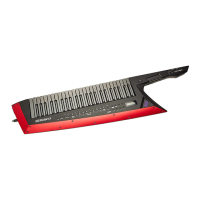
